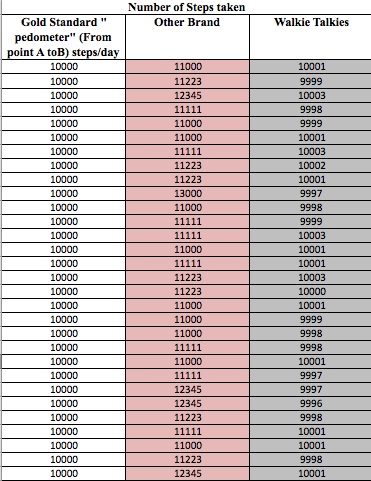BME100 f2014:Group3 L3
| Home People Lab Write-Up 1 | Lab Write-Up 2 | Lab Write-Up 3 Lab Write-Up 4 | Lab Write-Up 5 | Lab Write-Up 6 Course Logistics For Instructors Photos Wiki Editing Help | |||||||
|
OUR TEAM
LAB 3A WRITE-UPDescriptive StatisticsMean for Temperature and Heart Rate Gold Standard Temperature: 97.53 Spree Temperature:103.41 Gold Standard Heart rate: 91.68 Spree Heart Rate: 92.823
Gold Standard Temperature: .8627 Spree Temperature: 3.007 Gold Standard Heart Rate: 21.09 Spree Heart Rate: 21.485
Gold Standard Temperature: Spree Temperature: Gold Standard Heart Rate: Spree Heart Rate:
Gold Standard Temperature: Spread: 94.2-99.4 Range: 5.2 Variance: 0.744 Spree Temperature: Spread: 97-110 Range: 13 Variance: 9.042 Gold Standard Heart Rate: Spread: 42-188 Range: 146 Variance: 444.788 Spree Heart Rate: Spread: 44-179 Range: 135 Variance: 461.605
Results
AnalysisThe spree only had 4 numbers (1-4), and a normal oral thermometer has many number. The scale for the spree was level 1 is 97 degrees, level 2 is 103 degrees, level 3 is 110 degrees, and level 4 is 116 degrees.
Correct Conclusions From The Test: There is a strong positive correlation for the heart rate devices, but no correlation for the two temperature devices.
The subject that had the headband on consumed caffeine in the middle of the trials, which left room for error. Also, the subject had ice in her mouth. This made the reading of temperature by mouth colder than the actual value of her core body temperature.
Summary/DiscussionFlaws: The Spree headband records temperature by levels rather than by an exact number. The headband records four different levels that indicate a range on temperature from the user. For instance, level one indicates a temperature of 97, level two indicates a temperature of 103, level three indicates a temperature of 110, and level four indicates a temperature of 116. The spree does not provide an accurate or exact reading of temperature. The placement of the spree headband can also leave room for error depending on the levels of sweat that the particular place of the freehand contains. Core temperature and skin temperature vary dramatically based off the sweat levels and pigment of the skin. For instance, if the weather outside in extremely cold or extremely hot, the device would record a temperature measurement that is colder or hotter than the actual core body temperature of the user. Overall, temperature based off of touch of skin is not an accurate measurement.
LAB 3B WRITE-UPTarget Population and NeedWalkie Talkies are targeted towards people of all ages who desire to meet certain fitness goals, such as gaining or losing weight, or simply want to track their activity and stay motivated to make healthy choices. Walkie Talkies constantly track the user's weight, GPS location, and activity level, but the feature that makes them truly unique is their periodic vocal reminders to stay on track.This feature means that Walkie Talkies will be especially effective for those who have tried other fitness monitors before but still lacked the motivation to follow through with their health goals. Because Walkie Talkies monitor weight directly instead of users manually entering their weight like with most other fitness trackers, users cannot lie about their progress. Additionally, Walkie Talkies' GPS location monitoring ensures that user's will be warned not to stop in at the McDonald's they are currently walking past for lunch, making healthy choices much simpler.
Device DesignInferential StatisticsDistance:
GraphDistance: Weight: Number of Steps:
|
|||||||
























